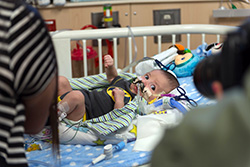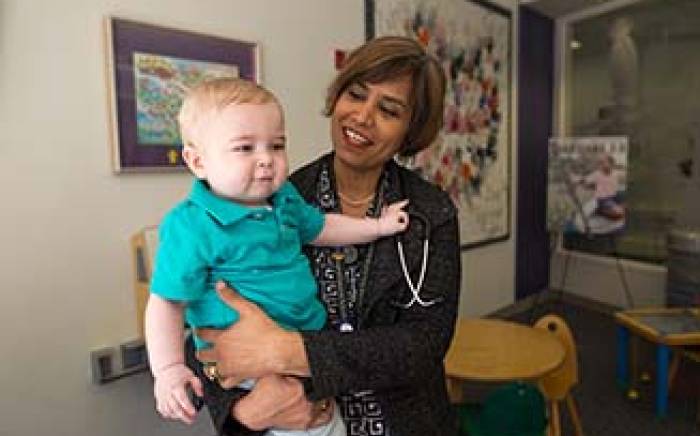Team providing care celebrates 30 years, 1,000 treatments, improved outcomes
 Six-month-old Avory Flare’s life was saved twice at St. Louis Children’s Hospital.
Six-month-old Avory Flare’s life was saved twice at St. Louis Children’s Hospital.
Avory has had seven surgeries already to repair his organs. He has a birth defect, congenital diaphragmatic hernia, in which his left diaphragm didn’t form. As a result, organs normally found in the abdomen moved up to the left side of his chest, impairing the development of his lungs and breathing.
“I love Children’s Hospital – I wouldn’t want Avory’s life in anyone else’s hands,” says his mother, Lysett Villagrana, who lives near Carbondale, Ill. “The staff and doctors here are fast-acting. If something suddenly goes wrong, they’re on top of it.”
In each instance Avory needed a treatment of last resort, extracorporeal membrane oxygenation (ECMO), to save his live because of his lung issues.
Extracorporeal means ‘outside the body,’ and ECMO is most often used in infants and children who are sick due to breathing or heart problems.
The ECMO machine uses a pump to circulate blood through an artificial lung back into the bloodstream. The system provides heart-lung bypass support outside the body. Oxygen is supplied to the patient while allowing time for the lungs and heart to rest or heal.
“ECMO is the ultimate backup, the ultimate safety net for a child or newborn,” says Washington University physician Adam Vogel, MD, pediatric surgery, ECMO program co-medical director. “It doesn’t fix the underlying problem, but it provides the support a patient needs and gives us time to address the issue.”
Starting ECMO requires a large team representing multiple disciplines – more than 50 clinicians at SLCH -- to stabilize the patient, as well as the careful set-up and priming of the ECMO pump with fluid and blood. Surgery is performed to attach the ECMO pump to the baby through catheters that are placed into large blood vessels in the chest, neck, or groin.
Without ECMO, many patients would not survive.
”Interacting with the families of these patients at such a difficult time can be hard, but I love being able to connect with them over our shared hope that ECMO may help save their child,” says Nicole O’Connor, BSN, RN, RNC-NIC, ECMO coordinator. “ECMO cannot save everyone, but for those that it does, the gift of life is something to cherish.”
Five months after his second treatment, Avory is doing well and is now home from the hospital.
A proud history: 30 years, 1,000 treatments
The team that administers extracorporeal membrane oxygenation (ECMO) treatment is celebrating its 30th anniversary this year and provided its 1,000th treatment in July.
The ECMO team includes more than 50 people from multiple specialties, including ECMO specialists, nurses, perfusionists, respiratory care therapists, surgeons, and newborn medicine and critical care physicians.
Team members must complete ongoing training each year. Two team members are assigned to monitor the patient at all times, as even seemingly minor variations in treatment can be catastrophic.
“Children who require this complex level of care to stay alive need a broad spectrum of expertise,” says Washington University physician Pirooz Eghtesady, MD, PhD, co-director of The Heart Center and co-medical director of the ECMO Program. “No matter what the outcome, we learn from every patient, we learn from each other and strive for excellence.”
Continuously improving outcomes
Clinical outcomes for ECMO patients at SLCH compare favorably with the international registry of ECMO patients:
- Outcome for all patients internationally, 2014: 59 percent survival
- Outcome for all SLCH patients, 2005: 60 percent survival
- Outcome for all SLCH patients, 2014: 71 percent survival
Recent advances include:
- Formation of an anticoagulation (blood thinner) team. There is a huge risk for devastating clotting and bleeding while a patient is on ECMO, and SLCH has a group of experts working together to manage anticoagulation to improve outcomes.
- ECMO transport. Patients with complex heart conditions and advanced lung disease requiring specialized care at SLCH have an option for transport with the ECMO team and mobile ECMO unit. A compact and portable 22-pound CardioHelp ECMO circuit, about the size of a suitcase, is used to support the patient on the way to SLCH. Only a handful of centers around the nation provide pediatric ECMO transport.
- Neurodevelopmental program. Provides follow-up assessment and support for therapies to improve neurodevelopmental outcomes.
The team earned the Center of Excellence Award from the Extracorporeal Life Support Organization, which signifies:
- A commitment to exceptional patient care
- An assurance of high quality standards, specialized equipment and supplies, defined patient protocols
- Advanced education of all staff members


